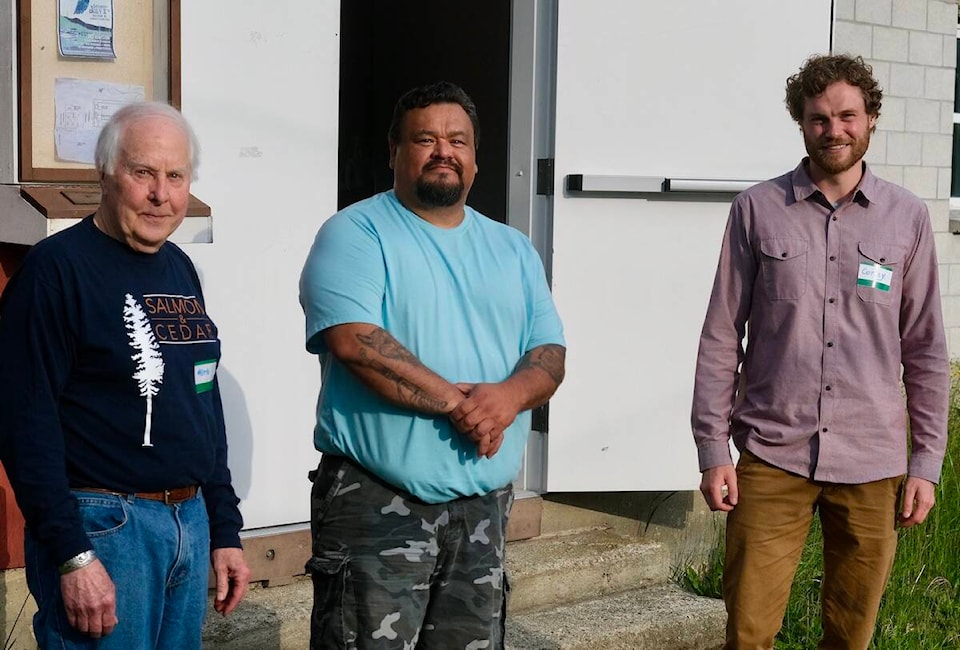For Chad Luke, the changes to Kootenay Lake over the past decades originated with dams and are about salmon.
“When it comes to fish and the dams, it actually hurts my feelings,” he told about 30 people at the Kootenay Lake Summit on May 25.
“As a Ktunaxa person, it hurts me. Why? Because my generation, and the generation before mine, never had the opportunity to have salmon. Why? Because of the dams.”
Luke, who is a band councillor at Yaqan Nukiy (the Lower Kootenay Band near Creston), was one of three guest speakers at this year’s summit organized by the Friends of Kootenay Lake, held at the Balfour Hall.
“But I’m not here looking for sympathy,” Luke said. “I’m looking for allies, and not for us to look at each other as brown or white or whatever. We all have the same goals.”
Those goals are the ecological health of Kootenay Lake.
Climate change and clearcut logging
Slocan Valley forest ecologist Herb Hammond, another guest speaker, said the health of the lake and of its surrounding forests are the same thing.
“Ecosystems that make up the forest and the lake can be thought of as a living fabric woven together by water,” he said. “Take water out of that picture and you don’t have that fabric any more.”
The most direct relationship between forests and the lake is the hundreds of small creeks, some of them running all year round, some of them intermittent, and some not there every year, he said. Those creeks and their watersheds are what sustains and feeds the lake, he said, providing pure water and nutrients.
“If you change the composition and structure of those watersheds, you change the nutrients that are delivered in through those creeks to the lake.”
The creeks also regulate temperature and are the key to overall biodiversity in the forest and the lake, Hammond said, adding that the timing of the flow is also crucial.

He said the Interior wet belt is a unique forest type formed due to the amount of precipitation, both snow and rain, but precipitation patterns and runoff patterns are changing due to stresses placed by climate change and clearcut logging.
“The way to take some of that pressure off is to ensure that we can keep things as as wet as as possible,” Hammond said. “And to do that, we want to keep the forest cover as intact as we can.”
He said there are studies that suggest that the Interior rainforest is endangered.
“If we continue to peck away at that forest, that core area could collapse within the next 20 years, and the primary reason is clearcut logging.”
Hammond said the biggest difference between clearcut logging and natural disasters like fire, floods, and windstorms is that the natural disasters don’t put the trees on a truck and carry them away.
“Natural disturbances leave the tree bodies behind. They fall to the forest floor, where they provide the framework for future forests — forests are built on dead trees.”

Luke gave a personal response to Hammond’s comments about forest and lake health.
“If the lake is unhealthy, are we going to be healthy?” Luke asked. “If the watersheds are unhealthy, are we going to be healthy? You know, if the land’s not healthy and the fish aren’t healthy, I’m not healthy. Because in our creation story, animals are first and I’m secondary.”
How lakefront landowners can help
The third speaker at the summit was RDCK planner Corey Scott, who talked about the shoreline damage done, often inadvertently, by landowners.
He explained that there are three ways property owners destroy beachfront ecosystems: vegetation clearing, beach trimming, and hardscaping.

Vegetation clearing results in less food for the organisms that fish depend on, warmer water temperatures and therefore poorer fish habitat, increased erosion and sedimentation, and less effective stormwater filtration.
Beach trimming means the removal of large woody debris and boulders, which can result in loss of complex habitat, increased erosion, less spawning habitat, and less plant regeneration.
Hardscaping means building retaining walls, stone walls or groynes (breakwaters). These can interfere with stormwater runoff, increase erosion and sedimentation, and destroy the connectivity between forest and lake which in turn threatens longterm biodiversity.

Scott said there are three ways the RDCK can attempt to deal with these issues.
1. Promote a culture of stewardship in the region and provide education about shoreline ecosystems.
2. Simplify and clarify existing shoreline development guidelines. These are “pretty confusing and not easy to find,” he said, and consist of a mix of development permit areas, setback rules, zoning, and the BC Building Code.
3. Enforce the rules. He said the RDCK is considering ticketing options, which are simpler than the current option of going to court. He said rapid enforcement is particularly important in riparian areas.
“When heavy machinery is out on site, the clock is ticking. So we (RDCK) have to get out there onto the site to take a look at what’s happening.”
Luke picked up on Scott’s comments about enforcement, expressing doubt that this would happen because the RDCK staff doesn’t want to get into conflict with landowners.
“Enforce it,” he said. “Yeah, you will get people pissed off at you, but … how serious are you when you talk about that? How serious are you guys at the RDCK to enforce that?”
The summit event also included group discussions, a silent auction, and dinner. It’s the first summit after two years of cancellations due to the pandemic.
bill.metcalfe@nelsonstar.com
Like us on Facebook and follow us on Twitter
